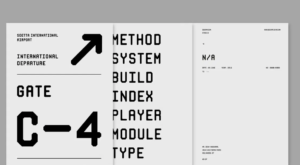Digital fonts have revolutionized the design and typography landscape, offering an unprecedented array of choices for enhancing visual appeal and enriching user experience. Gone are the days when designers were confined to a limited selection; today’s digital technology puts a vast spectrum of typography at their fingertips, transforming how we perceive design with a diverse range of font choices.

digital fonts
The importance of choosing the right font
In the realm of design, the significance of font choice is paramount. Fonts are pivotal in setting the tone and conveying the message of a design, capable of evoking specific emotions and crafting a distinct atmosphere. Whether for a website, logo, or printed publication, selecting the right font is essential to the success of the overall design, taking into account the target audience, the design’s purpose, and the overarching brand image.
How digital fonts enhance visual appeal
The advent of digital fonts has unlocked a treasure trove of possibilities for designers, enabling them to experiment with a wide range of styles from classic elegance to modern boldness. Digital fonts not only allow for the creation of unique and visually captivating designs that grab attention but also offer customization options to tailor fonts to specific design needs, thereby elevating the visual appeal and distinctiveness of their work.
The role of digital fonts in user experience
User experience is paramount in design, and digital fonts are key to enhancing this aspect by ensuring content is readable and legible. A carefully chosen font can significantly improve content comprehension, foster a sense of familiarity, and enhance the overall user experience. Conversely, an ill-suited font can hinder readability and alienate users. Balancing aesthetics with functionality is crucial when selecting a digital font for any design project.
Different types of digital fonts and their characteristics
Digital fonts come in various types, each with unique features. Serif fonts, like Times New Roman, are distinguished by their decorative strokes and convey a sense of tradition and professionalism. Sans-serif fonts, such as Arial or Helvetica, offer a clean, modern aesthetic and are favored for their readability in digital designs. Script fonts, which resemble handwriting, add elegance or informality, while display fonts are ideal for making bold statements in headlines and large-scale designs.
Tips for using digital fonts effectively
To leverage digital fonts effectively, designers should adhere to several best practices. Maintaining consistency by using a limited number of fonts helps achieve a cohesive look. The choice of font should align with the design’s context and intended emotional impact. Attention to spacing and kerning is essential for readability, and testing fonts across various devices ensures a consistent and legible user experience.
Examples of successful use of digital fonts in design
Digital fonts have played a pivotal role in crafting visually stunning designs for brands like Chanel, whose iconic double-C logo epitomizes elegance and sophistication with a custom digital font. Similarly, Airbnb’s website design skillfully combines sans-serif and serif fonts to create a welcoming yet modern aesthetic. These examples underscore how strategic font choice can significantly enhance a design’s visual appeal and reinforce brand identity.
Tools and resources for finding and using digital fonts
Accessing and utilizing digital fonts is easier than ever, thanks to a wealth of resources and tools. Platforms like Google Fonts, Adobe Fonts, and Font Squirrel offer extensive collections of free and premium fonts that can be seamlessly integrated into designs. Adobe Creative Cloud and other design software provide a plethora of font options and customization features, while online typography communities offer insights, recommendations, and reviews to help designers stay abreast of the latest trends.
The future of digital fonts and emerging trends
The future of digital font is bright, with advancements in technology like augmented reality and virtual reality opening new avenues for typographic innovation. The rise of variable fonts, offering unparalleled flexibility and customization, promises a consistent and optimal reading experience across different devices and resolutions. Designers are also exploring non-traditional, experimental typefaces to push the boundaries of design and create unique visual narratives.
Conclusion
Digital fonts have transformed the landscape of design, significantly enhancing both visual appeal and user experience. By selecting the appropriate font, designers can craft visually arresting designs that not only capture attention but also effectively communicate the intended message. With a plethora of styles and customization options at their disposal, designers are equipped to produce memorable designs. As technology evolves, the potential for digital fonts in typographic design continues to expand, heralding an exciting future for designers willing to explore and innovate.
